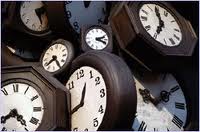We have decided to condense a 24-hour working day into a 6-hour performance that incorporates a typical everyday routine. We aim to highlight how time can be both an abstract and physical concept by which we are controlled. On the other hand, we cannot help but manipulate time in this piece as measurements of time are a human invention (e.g. seconds, minutes.)
The performance begins with us inert in a sleeping position for the duration of the first hour; we then are individually awoken by a series of alarms to perform our morning routines in a mechanical manner and in time to the sound of a ticking clock. Each member of the group stands in front of a section of the glass cabinets to perform their own daily routine as if the glass is a mirror. In three pairs, we reflect actions of each other brushing our teeth, washing our face and eating breakfast for 15 minutes per action, each pair performs the actions in various tempo’s but making sure to keep in time with the clock ticking sound still. We have included three videos displaying an example of the various tempos that each pair will use.
The first, shows the slowest speed whilst keeping to the ticking of the clock and the last video displays the fastest speed which still keeping to the beat.
Through the manner of miming, we display how a lot of our daily actions are mechanical and we perform them without thinking about the amount of time it consumes. By the end of the second hour, we will portray the walk to work by using an exercise we previously created as a warm-up. It incorporates using the space in Gallery 3 and moving in a mechanised style.
In the third and fourth hours, we will be aiming to represent a working day through the medium of constructing the puzzle of a clock made from carpet tiles. This serves to act as a reminder of the works of James Usher and how clocks were a key feature of both his public and private life. Between these hours, we will be including a 15 minute lunch break eating pineapple related foods, which is part of the performance, reflecting the exhibition of the ‘Pineapple Dish’ currently housed in the gallery. At the end of the fourth hour we will perform the walk through the space exercise previously used as the ‘walk to work’ but changing it to represent the walk home.
For the final hour, we will represent the evening period of a typical day which will display dinner time, relaxation or recreation time (working as a group to incorporate a game into the performance e.g. a passing ball game) and finally finishing the performance in the position by which we began, sleeping. This position will not be held as long as it was at the beginning of the performance as it is just a brief representation of the end of a typical day.




 Left: Grandfather clock
Left: Grandfather clock 